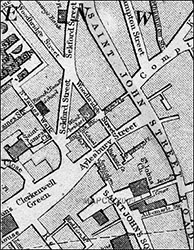|
|||||||||||||
| Article by Brenda Lofthouse, 2017 |
|||||||||||||
|
Thomas Britton
|
|||||||||||||
|
Thomas Britton, the Small-Coals Polymath
Thomas became widely known to the public around his area of London because of his trade and his musical ability. Thomas never gave up being a small coal man, and in this he may have been exceeding astute. His background would never have allowed him access to the wealthy levels of society. However as a very talented small coal man he did not threaten the established hierarchy but became an acceptable novelty. He was an object of sociological speculation. His fame spread. Jonathan Swift wrote a poem in April 1709 “A Description of the Morning” which referenced him, “ The small-coal man was heard with cadence deep; / Till drown’d in shriller notes of ‘chimney sweep’”. Whilst acknowledged as a polymath, it was the musical concerts he organised that contributed to his lasting fame. In 1745 his neighbour and friend Edward Ward, wrote about the musical evenings as a tribute to Thomas, thirty years after his death. “The Prudence of his Deportment, among those who were his Betters, procured him great Respect from all that knew him, so that his Musick Meeting improved in a little Time to be very considerable, insomuch, that Men of the best Wit, as well as some of the best Quality, very often honoured his musical Society with their good Company, that in a few Years his harmonious Consort became as publickly noted as the Kit-Cat Club” (6). His Thursday evening concerts became the gig to attend. Ladies of fashion clambered up the outside steps to squeeze into his upper room, their dresses sweeping the floor. It was not so much life at the coalface as listening to music facing the coals. Accomplished musicians played with Thomas and friends, including, it is thought, George Frederic Handel, prior to Handel being taken up by royalty. Thomas’ preferred instruments were the viol de gamba and the recorder. His interest in the history of music was recognised by Samuel Pepys, who regarded Britton as an expert on Tudor music. On the 9th December 1673 when Thomas was 29 he married Allice Cleapte in St James Church, Clerkenwell. There is no evidence that they had children but it could be suggested that Allice was a very calm and accommodating person as Thomas was a compulsive collector. Somewhere, stored in his home by the time of his death, he had collected over fourteen hundred books, vocal music sheets, musical scores including Purcell’s opera Psyche, and nearly forty musical instruments. A sale was held after Thomas’ death and Sir Hans Sloane bought many of the items, and on whose own death the majority of the items were then bought by the government and formed the basis of the British Museum. It is rather neat that the man whose surname was Britton in effect contributed so much to the British Museum. As remarkable as Thomas’ life was, his death was equally individual. Thomas was known to be excessively superstitious. At one of his musical evenings a Justice of the Peace named Robe brought a ventriloquist called Honeywell to the meeting and this man threw his voice and stated in sonorous tones that unless Thomas fell to his knees and repeated the Lords Prayer immediately he would be endangering his soul and would die within a few hours. Thomas complied, unaware that he was being the butt of a joke, but the effect on him was disastrous as he died a few days after the event from shock. His wife survived him but one article seemed to suggest that this was bad form on her part. “His wife lived for some years after his death, which was very singular and somewhat premature” (7). Thomas was buried in the vault at St James, Clerkenwell on the 1st October 1714. His funeral procession was accompanied by a lot of mourners, and it is to be hoped that Justice Robe and Mr Honeywell were chief among them. In the early twentieth century the vault was excavated and equipped to form a large hall. Princess Marie Louise of Schleswig-Holstein opened the new space in 1912. The three hundred coffins that had previously been placed in the vault were moved and stored under the main West entrance to St James, which presumably is where Thomas remains to this day.
References:
The picture of Thomas Britton is in the Handle Museum, Duke Street, London. It was painted by his friend, John Wollaston, in 1703, when Thomas was 59 years old.
(1) Cole, John. The History and Antiquities of Higham Ferrers 1838 p174. (2) John Hawkins, Sir. A General History of the Science and Practice of Music 2nd Edition (1875) P788. (3) Northampton Mercury, 02 December 1776. (4) Thornbury, Walter. Old and New London, A Narrative Of Its History, Its People, And Its Places. Vol 11. 1880. P 334 (5) Letter to The Gentleman’s Magazine, September 1773. P 437. (6) Ward, Edward. A Compleat and Humorous Account of all the Remarkable Clubs and Societies in the Cities of London and Westminster, London 1745. (7) F F. Article in The Repository of Arts, Literature, Fashions, Manufactures etc Vol X. December 1820
|
|||||||||||||
|
|
|||||||||||||
|
see also Thomas Britton and Thomas Britton 2 and his will
|
|||||||||||||
|
|
|||||||||||||
|
|



